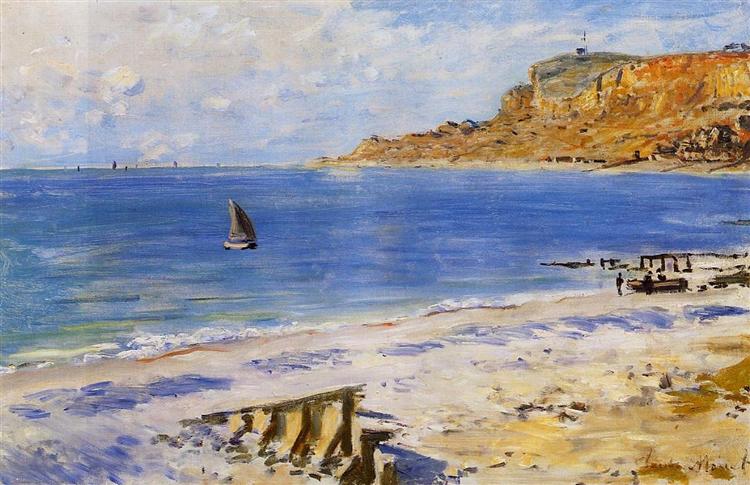Beschrijving
In Claude Monet's painting Sailing at Sainte Adresse (1873), we find a vivid example of the development of Impressionism, an artistic movement that Monet helped define and popularize throughout his career. This painting, made during his stay on the Normandy coast, evokes an atmosphere of serenity and is a testament to Monet's exquisite mastery of light and color in his compositions.
The scene presents a panoramic view of the port of Sainte-Adresse, where the term “sailing” takes on two meanings: on the one hand, the movement of the boats that plow through the waters, and on the other, the pictorial journey through visual perception that Monet proposes to his viewer. The composition is structured in such a way as to capture the action of the sea in harmony with the daily activity of life on the coast. Monet uses a color palette that oscillates between vibrant blues and warm golds, evoking the luminosity of the day. The tones of the water contrast with the masses of clouds floating in the sky, which are represented by loose and rapid brushstrokes that suggest movement and, at the same time, the ephemeral nature of light.
At the bottom of the painting, a series of small sailing boats can be seen, their white sails blowing in the wind, seemingly dancing on the water. These nautical elements are central to the composition, bringing dynamism and a sense of scale to the painting, in contrast to the more static background of the coastline and gently rising buildings. This use of colour and form resonates in other works of Impressionism, which seek to capture not just the image, but the sensory experience of the moment.
The characters in the painting, although not the central focus, add a human touch that contributes to the narrative of the scene. On the shore, there are figures that seem to interact, thus encapsulating the relaxed and pleasant atmosphere of a day at the coast. Although Monet does not dwell on the details of the faces or features of these figures, their presence is essential to suggest a story and bring this coastal gathering to life.
The choice of Sainte-Adresse as a subject is also due to his personal ties. Monet spent time here with his family, and the work can be seen as both a tribute to his surroundings and a technical exploration of his art. The simplicity of the setting is enriched by the lyrical character of the painting, evoking feelings of nostalgia and calm.
The loose brushstroke technique that characterizes Sailing at Sainte Adresse is quite representative of Monet's approach to Impressionism, where immediacy and visual perception are paramount. In this period, Monet began to experiment more boldly with light and shadow, seeking to capture fleeting moments, something that manifests itself in the almost painterly quality of the painting's surface. The work invites the viewer to reflect on the transience of time and the ephemeral beauty of the landscape.
"Sailing at Sainte Adresse", though it may seem like a simple study of a seascape, distills the fundamental principles of Impressionism: changing light, atmosphere and the spirit of the moment. This painting is a milestone in Monet's oeuvre that celebrates not only the artist's technical skill but also his ability to evoke an emotional connection with nature and everyday life. In it, we find a balance between the natural and the human, the permanent in the ephemeral, making this work an enduring example of the great French master's legacy.
KUADROS ©, a famous painting on your wall.
Hand-made oil painting reproductions, with the quality of professional artists and the distinctive seal of KUADROS ©.
Painting reproduction service with satisfaction guarantee. If you are not completely satisfied with the replica of your painting, we will refund 100% of your money.

